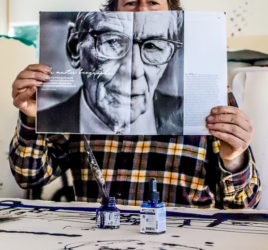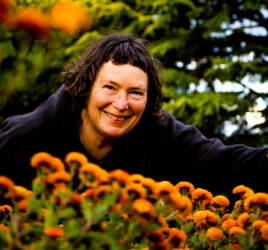
Father and son in the wilderness
Myles and Milo Dunphy
In the Easter holidays of 1931, a group of bushwalkers set out to explore the Grose River Valley – a pristine wilderness area to the east off Govett’s Leap in Blackheath. They were headed for Blue Gum Forest – an area famous for its tall, majestic stands of the rare gum, Eucalyptus Deanii. As they approached the forest, Clarrie Hungerford appeared on horseback, announcing that he had secured a lease over the forest, and planned to clear the trees and establish a walnut farm. According to one account by Myles Dunphy, who was one of the bushwalkers, the party could already hear the sound of axes ringing out around the valley.
Sometimes when he recalled the story, Dunphy said they came across two bushmen carrying axes who intended to ringbark the trees. This version has been disputed by other members of the bushwalking party and, indeed, Myles himself gave several contradictory accounts over the years. Whatever happened between the walkers and the bushmen that day in Blue Gum Forest, the incident led to much more than just the preservation of the land.
In 1931, this valley remained undisturbed, despite numerous attempts to make way for roads, railways, sawmills and coal mines. The bushmen made it clear that the only way the walkers could save the trees would be to compensate the leaseholders, that is, themselves, for their losses. The walking group made an initial down payment on the land and spent the next year trying to raise enough funds to secure their purchase.
 With the property exchange settled, they had won the battle. Now it was time to win the war. The bush walking club began an expensive, self-funded campaign, lobbying the State government to reserve the Blue Gum Forest as a National Park. The public relations drive included a four page supplement in the Katoomba Daily during 1934, pleading the case for the preservation of the bushland environment.
With the property exchange settled, they had won the battle. Now it was time to win the war. The bush walking club began an expensive, self-funded campaign, lobbying the State government to reserve the Blue Gum Forest as a National Park. The public relations drive included a four page supplement in the Katoomba Daily during 1934, pleading the case for the preservation of the bushland environment.
The Katoomba Daily Supplement featured a detailed topographical map designed by Myles Dunphy, which outlined a 4662 square kilometre National Park proposal. The plan was to create a Greater Blue Mountains National Park, extending from the Wollemi in the north to the Nattai in the South. The bush walking club’s purchase of a small parcel of wilderness in the Grose Valley was the genesis for the dedication of the Blue Mountains National Park as we know it today.
Peter Meredith’s recently published biography of Myles Dunphy and his son Milo is a study of the origins of the conservation movement. Myles and Milo spent their lives fighting to conserve most of the areas now designated as National Parks in Australia.
Myles spent his early years walking all over New South Wales. He walked the Blue Mountains, the Snowies, Myall Lakes and beyond. Continually frustrated by the inadequacy of most of the maps available, Myles began drawing his own maps – many of which are still in use today.
Myles Dunphy so loved the Mountains that he gave his son Milo the middle name ‘Kanangra’. He and his wife even carried the baby across the Mountains to the Kanangra Walls in a specially modified pram. The boy Milo was indoctrinated into all facets of bushcraft from the cradle. It was almost inevitable that he would follow in his father’s conservationist footsteps. Milo, like his father, was an architect by profession, yet his position as Executive Director of the Total Environment Centre freed Milo to pursue his environmental interests, without having to practice as an architect throughout his life.
Peter Meredith’s biography has received negative reviews for focusing too much on Milo Dunphy’s lifestyle – particularly his extra-marital infidelities. There is no question that his personal life, right from the moment of marriage, had a profound effect on his life’s work.
Milo was in England on a scholarship when he met Dorothy and pursued her in a courtship contest with a colleague. Milo won the contest but by the time they married, merely a few weeks later, Dorothy was already with child. Milo abandoned his plan to study at Harvard, postponed his scholarship thesis, and moved into survival mode. His flourishing career came to an abrupt halt as the couple made a desperate return to Australia to establish themselves financially. They also faced the difficulty of concealing the dates of conception from Milo’s devoutly Methodist parents and extended community, carrying the sense that he had wasted opportunity with him to his grave – a circumstance probably best classified as ‘the human condition’.
Milo Dunphy played a pivotal role in maturing the green movement into a potent political force in Australia. He took politicians, including Neville Wran and Bob Carr, into the bush to convert them to his cause.
The story of Myles and Milo follows the lives of two of Australia’s most outstanding – and original characters. Their lives span the century, as well as the full gamut of human experience, from professional careers to relationship breakdown.
Miles and Milo is published by Allen and Unwin, and is available from Megalong Books and other bookstores.




Hi Elisabeth. At the bottom of the blue gum vally, where the two streams join, there used to be a book in a tin box that visitors could sign, I wonder if such a book still exists. I made an entry in the late 60’s on route to bridel veil falls in the Grose vally, quite an experience. Your research probably goes a long way to explaining how come there was wild horses down there at the time. Cheers. John.